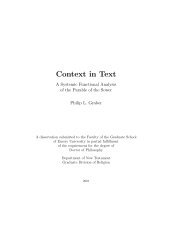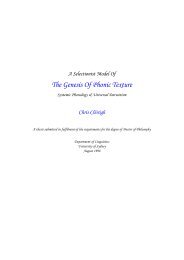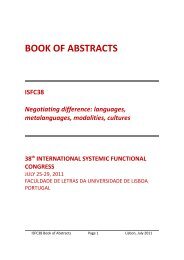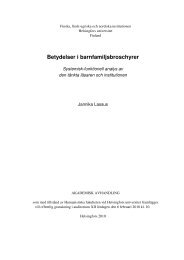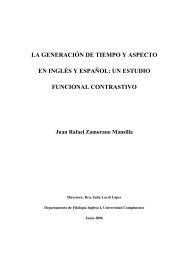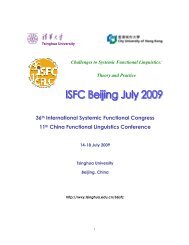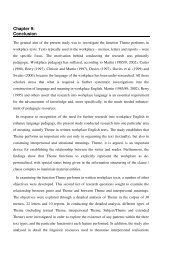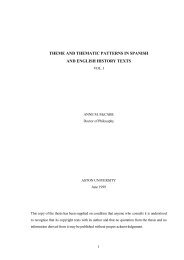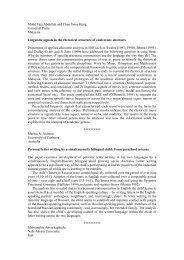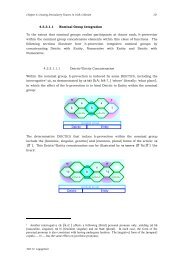the ISFC39 Proceedings - International Systemic-Functional ...
the ISFC39 Proceedings - International Systemic-Functional ...
the ISFC39 Proceedings - International Systemic-Functional ...
You also want an ePaper? Increase the reach of your titles
YUMPU automatically turns print PDFs into web optimized ePapers that Google loves.
Papers from <strong>the</strong> 39th ISFCdegree of concretisation. The final student text included two levels of semantic gravity in <strong>the</strong>one musical excerpt by including <strong>the</strong> improvisation in <strong>the</strong> top line of <strong>the</strong> system, and <strong>the</strong>chord conveyed by that improvisation on <strong>the</strong> bottom line. This demonstrates <strong>the</strong> affordancesof notation for providing parallel layers of meaning, but is problematic for depicting in asemantic profile.Fur<strong>the</strong>r research is required to investigate whe<strong>the</strong>r <strong>the</strong> semantic wave in one modecontributes to knowledge-building or more successful writing. The consideration of <strong>the</strong>semantic waves does highlight <strong>the</strong> contribution of notation specifically and examplesgenerally in a text, and how <strong>the</strong>y may connect or disconnect from specific instances. A moresignificant application is to <strong>the</strong> intersemiotic construction of meaning with text elaborating onnotation.The categories of LVN were interpreted in light of Semantics. Intensive, possessive andcircumstantial identification unpacks information condensed in <strong>the</strong> notation, weakeningsemantic density. Possessive, circumstantial identification and manner streng<strong>the</strong>ned semanticgravity by locating it within its textual context and providing stronger alignment with itsembodied performance. Finally effect repacked <strong>the</strong> information with greater abstraction andgeneralisation across musical situations. The LVN analysis was conducted on two texts from<strong>the</strong> corpus, from <strong>the</strong> two students who have continued on to fur<strong>the</strong>r study. The triangulationwith Semantics was applied to <strong>the</strong> analysis of LVN. In <strong>the</strong> first text, which was characterisedby a semantic wave in <strong>the</strong> notation text types, a semantic wave was also observed in <strong>the</strong>linguistic text. Significantly though, <strong>the</strong> qualities identified by intensive identification couldbe more concrete, such as “<strong>the</strong> interval of a fourth”, thus weakening semantic density byunpacking <strong>the</strong> information condensed in <strong>the</strong> musical symbols, or could attain greatergeneralisation by abstracting qualities of <strong>the</strong> whole notational excerpt, such as “strongintervallic identity”, thus streng<strong>the</strong>ning semantic density and weakening semantic gravity byproviding observations applicable to new or multiple contexts. Thus <strong>the</strong> high points of <strong>the</strong>semantic profile were variously provided by ei<strong>the</strong>r intermodal intensive identification oreffect. By contrast, <strong>the</strong> second text analysed appeared to have a smaller semantic range; <strong>the</strong>effects described were strongly connected to <strong>the</strong> embodied experience of <strong>the</strong> listener in <strong>the</strong>given context, thus providing stronger semantic gravity than <strong>the</strong> first text’s abstractionsgeneralised across instruments, eras and contexts. Although <strong>the</strong> use of notation ensured <strong>the</strong>rewas some semantic variation, this might better be described as a semantic ripple ra<strong>the</strong>r than asemantic wave.5 ConclusionThe meanings made in musical notation can be understood by situating <strong>the</strong> texts withinHalliday’s model of instantiation and realisation. The triangulation of this understanding with<strong>the</strong> notion of semantic gravity from LCT demonstrates <strong>the</strong> semantic wave present in studenttexts as <strong>the</strong> different notation types incorporated vary in <strong>the</strong> strength of <strong>the</strong>ir relation to <strong>the</strong>irperformative context and in <strong>the</strong> degree of abstraction. These notation types variously construe<strong>the</strong> cultural context of jazz and <strong>the</strong> situation of performance and analysis. LanguageVerbalising Notation was briefly introduced as a framework for exploring how text elaboratesand expands on meanings made in notation. By again triangulating this with Semantics fromLCT it was found that information from notation was unpacked and related to its context ofsituation, and repacked with greater abstraction which speaks to <strong>the</strong> greater context ofculture, that is jazz performance.This research contributes to <strong>the</strong> understanding of music and music notation. It alsohighlights <strong>the</strong> repurposing of notation from performance for academic texts in a pedagogical187



